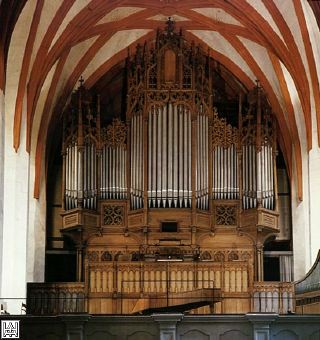J.S. Bach Mass in B Minor
Organization of Movements
Xinh's project for Mu123, spring/1996
[Bach home page]
Choir and Organ Loft of St. Thomas Church
by Alexandre H. Hohmann, 1996

Comparison with Catholic Mass
The structure of Bach's Mass in B Minor is based on the Roman Catholic mass text. However, Bach's organization of the 27 movements reflects his Protestant background. The traditional Catholic mass contains 5 major sections, while the movements in Bach's mass are grouped into 4 sections:
Catholic mass
Bach's B-Minor Mass
As shown above, Bach combined the Kyrie and Gloria into the Missa, according to the common practice of that time. He renamed the Credo as Symbolum Nicenum according to Lutheran tradition. Finally, the Osanna and Benedictus, which appeared in the Sanctus section of the Catholic mass was removed from the Sanctus by Bach and placed in the last section of his mass. In summary, the text used in the B-Minor Mass is the same as the traditional Catholic mass text, except that Bach modified the grouping of individual movements. The original order of individual movements, however, is retained.
Choruses and Arias
The individual movements are either choruses or arias, which are represented in even proportions throughout the work. The chorus movements feature the entire choir with orchestral accompaniment. The arias typically have a solo or duet vocal part and one or two obligatto instruments, accompanied by orchestra. Here I list the movements in order of performance:
I. MISSA
Kyrie
Gloria
II. SYMBOLUM NICENUM
Credo
III. SANCTUS
IV. OSANNA, BENEDICTUS, AGNUS DEI
Agnus Dei
[Back | Bach home page | Next]
Last updated: May 16, 1996
xinh@cco.caltech.edu
